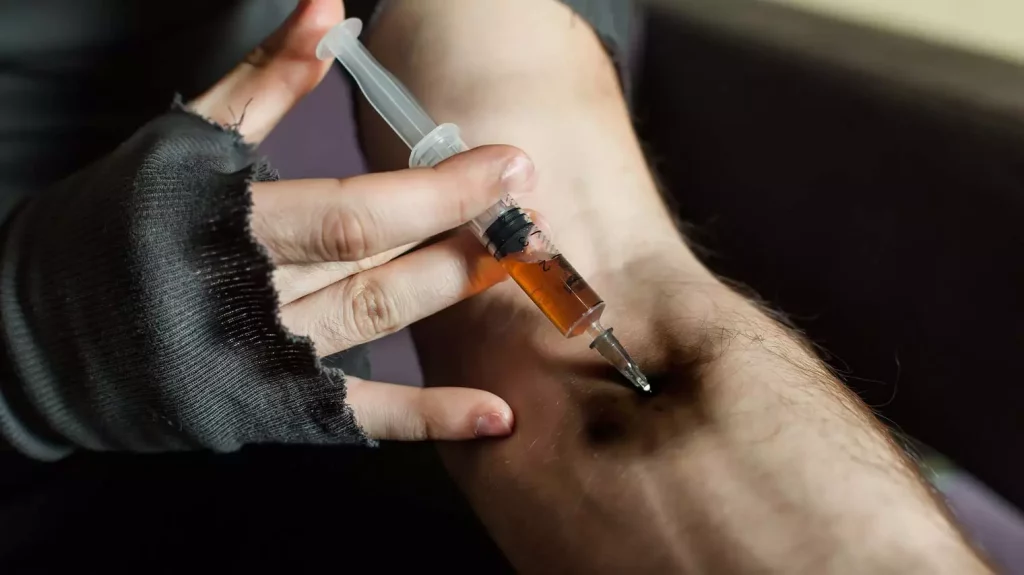What is Heroin?
Table of Contents
- What is Heroin?
- How Does Heroin Affect the Body?
- How is Heroin Used?
- What is “Shooting Heroin?”
- The Process Of Shooting Up (Injecting Heroin)
- Experiencing the High Produced by Heroin Use
- The Dangers of Injection Drug Use
- Signs & Symptoms of Intravenous Heroin Users
- Heroin Addiction Treatment Methods
- The Importance of Medical Detox in Heroin Addiction Treatment
- Inpatient Treatment for Heroin Injectors
- Outpatient Treatment for Heroin Injectors
- Dual Diagnosis Treatment for Heroin Addiction
- Finding Heroin Addiction Treatment and other Substance Abuse Recovery Services Near You
- Medically Reviewed By
Heroin is an opioid drug that is made from morphine, which is derived from the opium poppy plant native to Southeast and Southwest Asia, Mexico, and Colombia. Heroin is typically found as a white or brown powder, or in the form of a black, sticky liquid called black tar heroin. All of these forms can be used for shooting heroin, though some more commonly than others.
Like other illicit drugs, heroin can be extremely addictive, often leading people to form a dependency upon this drug fairly quickly. Furthermore, long-term heroin use can cause extensive damage to the individual taking this substance, both physically and emotionally.
How Does Heroin Affect the Body?
When taking this drug, heroin quickly makes its way to the brain, binding to opioid receptors located in many areas of this organ. In particular, heroin will attach itself to those found in the parts of the brain that are in charge of producing feelings of pain and pleasure.
These areas also control various bodily functions, including a person’s heart rate, as well as their sleep cycle and breathing. When this interaction occurs, individuals may experience a brief euphoric high and surge of energy.
This, however, will likely also cause a number of other far more unpleasant side effects, which can cause various health complications both with short-term and long-term use of heroin, including an addiction to this substance.
How is Heroin Used?
There are several methods of using heroin, each of which may produce a different or faster high. These include sniffing, snorting, or smoking heroin. In some cases, a person may mix heroin with crack cocaine to achieve a more intense high. This is known as “speedballing.”
While mixing heroin with other illicit drugs or alcohol may produce a stronger high, this is also extremely dangerous. Not only can it more quickly lead to the development of a drug addiction, but it will increase the individual’s risk of experiencing adverse side effects, including overdose.
Perhaps one of the most common, and most dangerous, methods of this drug use, however, is heroin injection. While any form of substance abuse can cause extreme harm to the user, drug injection poses several unique risks.
What is “Shooting Heroin?”
Shooting heroin, or “shooting up,” refers to the act of injecting heroin directly into the veins by using a needle. With injection drug use, the heroin travels to the brain much faster, making its side effects kick in almost immediately.
The euphoric and extremely addictive high this causes makes it extremely easy for heroin users to form a dependency on and addiction to the drug. This high is so intense that it can make people continue to practice this form of drug abuse, even with the extreme risks it presents.
While injecting is overstimulating at first, a tolerance is rapidly built up. That is why most heroin users who inject this drug have little interest in any other method of drug abuse, such as smoking or snorting it.
While “shooting up” is the most common way of referring to injection drug use, there are a number of other slang terms used to describe injecting heroin, such as “banging,” “firing up,” “slamming,” “hitting,” “hanging fire,” “booting” and “spiking.”
The Process Of Shooting Up (Injecting Heroin)
With heroin injecting, users will often follow a specific process when it comes to this method of administration. While not everyone will follow this particular substance use process, generally, heroin consumption via injection use will entail a series of steps, including:
- “Scoring” or acquiring the heroin
- Preparing the heroin
- Injecting the heroin
“Scoring” the Heroin
For many people who struggle with drug abuse, the ritual of shooting heroin in itself will become a sort of addiction to them. With this process, the first step is to “score” or acquire the heroin. As discussed, this drug is usually available in several forms.
Heroin injectors may choose to use either the base form of heroin, which may be white or brown in color and often resembles powdered milk, or its black tar variant. Both are usually packaged in a clear capsule, a small tied ballon, a tiny zip-lock baggie, or in the corner of a cut-to-size plastic baggie or glassine ‘envelope.’
Preparing the Heroin
Once the drug has been attained, heroin users will then begin to “fix” their product. To do so, the capsule or baggie is opened and the heroin is placed in a metal spoon or in a metal screw-on bottle cap (like those that come on a quart bottle of beer) with the plastic taken out.
A syringe is used to measure out water according to the individual user’s preference, which is then squirted onto the heroin. These syringes may also be called “needles,” “bats,” “sharps,” “points” and “sticks.”
Once the heroin is diluted, the syringe is taken apart so the plunger can be used to stir the substance while heat from a lighter or match is administered underneath the spoon or bottle cap. This is slowly stirred until it melts down into an injectable substance.
The syringe is then put back together and the heroin and water mixture is drawn into the syringe through a tiny wad of cotton to filter it out so that the syringe does not clog up. The filter is generally obtained from a small piece of cotton ball, Q-tip, or a shred of a cigarette filter.
Injecting the Heroin
Once the heroin has been prepared, the actual injection process will begin. Most heroin users who inject this substance have worn out their veins. This leads them to have to use various methods to “tie off” their veins, helping them to protrude so that drugs can be injected.
This may be done through using belts, long socks, elastic tubes and ties, purse straps, towels, strings, yarn and practically anything else that can be wrapped around the arm. Of course, injection heroin use may take place using veins in other parts of the body, as well.
While veins in the arms are convenient and most popular, when veins are collapsed, calloused, or become too obvious, those in the legs, hands, feet, neck, breasts (for females), groin, ankles and in between the toes may be used.
Once the vein is protruding and held in place, the user will insert the needle of the syringe into the vein, pushing the heroin in. The effects are immediate, usually beginning with a warm feeling in the throat accompanied by a taste that varies according to the type and drug quality.
As the heroin travels through the bloodstream to the brain, a warm feeling flows over the body, and euphoric feelings set in. This is called a “rush,” and may even have a pain-relieving effect. This, however, is only temporary, and will likely cause far more consequences than benefits.
A desperate individual struggling with heroin addiction may even try shooting up this drug by injecting it into one of their muscles, although the effect will not be as pronounced as in one of their veins.
Experiencing the High Produced by Heroin Use
When high, it is common for heroin users to drift off to sleep, which is referred to as “nodding” off. They may also experience nausea and/or vomiting, excessive itching, have a dry mouth (cotton-mouth), slow and slurred speech, and/or have a glazed over look about them.
Many will operate at a slower pace although, especially when the heroin is mixed with crack cocaine, they may also become overactive and even paranoid. Heroin may also commonly be mixed with other drugs, such as methamphetamine, alcohol, and various other substances.
The Dangers of Injection Drug Use
There are various dangers associated with injection drug use, particularly when it comes to heroin. Most individuals struggling with addiction are not known for being responsible. Those who inject heroin particularly face significant risk when it comes to the needles they use.
In many cases, a person may reuse their syringes multiple times, or may even share needles with others. There are many dangerous implications with these habits. When a heroin user injects this drug, missing their vein can cause the drug to go into the wrong area.
Missing the vein can cause an abscess, which is especially dangerous for those who hit in their neck or near the heart. Furthermore, once a vein has been overused, it tends to collapse, which is destructive to the circulatory system.
There are also the dangers associated with sharing needles, such as an increased HIV risk, as well as that of Hepatitis B and Hepatitis C virus infection, blood-borne viruses, and a host of other medical conditions. Furthermore, there is always the possibility of overdose and death.
Signs & Symptoms of Intravenous Heroin Users
Admitting that you or a loved one may be struggling with substance abuse can be hard. However, heroin use, especially for injection drug users, can be extremely dangerous even with just one use, let alone when continuing these habits over long periods of time.
Thus, it is essential that you know how to recognize the signs of heroin abuse, so that these habits can be properly addressed before they are able to get any worse. Some of the tell-tale physical and behavioral signs that someone is injecting illicit drugs include:
- Physical traits such as being overly sleepy or having slurred speech or overly active and talkative
- Exaggerated emotions like extreme highs and lows with bouts of depression when the drug wears off
- Being sick, often experiencing vomiting and flu-like symptoms
- Changes in eating habits, particularly eating too little or very sporadically
- “Tie off” paraphernalia around the house, especially in the restroom areas
- Spoons with black char marks on the bottom
- Bottle caps with the plastic insert pulled out and burn marks on the underside
- Q-tips or cigarette filters that have been pulled apart
- Tiny balls of cotton, especially in the restroom or area you suspect drug activity to be taking place
- Needle marks (tracks) on any area housing veins, even in between the toes
- The wearing of long sleeves even in the summertime
- Metal spoons missing
- Bottles of water opened but barely used (fixing usually takes only about 40 small ‘units’ of water)
- Syringes or broken needles
- Empty baggies or capsules, balloon fragments, or baggies with the corners cut off
Heroin Addiction Treatment Methods
Those seeking treatment for their heroin abuse, particularly those who are injection drug users, will need to seek out professional addiction treatment services in order to have their best chance of achieving and maintaining sobriety.
This is because, once they stop or drastically reduce their heroin use, they will very likely develop withdrawal symptoms. These occur because the body and brain are no longer receiving a drug they have become dependent upon, disrupting their system’s chemical balance.
This is why, for most people receiving treatment for heroin addiction, their recovery process will typically start with their participation in a medical detox program. Once detox is complete, they will be encouraged to seek further care through inpatient or outpatient treatment programs.
The Importance of Medical Detox in Heroin Addiction Treatment
When recovering from addictive drug use, the withdrawal symptoms a person may develop can be quite dangerous, and may even be life-threatening for those with more severe addictions; such as, of course, injection heroin use.
Medical detox programs can help these individuals manage and even prevent many of these dangerous health consequences by gradually weaning them off of their heroin use, while under constant support and supervision of licensed medical professionals.
This treatment process may also involve the administration of certain addiction medicines, which can further help combat and prevent withdrawal symptoms, as well as reduce drug cravings, and the individual’s risk of relapse.
Heroin Withdrawal Symptoms
For those recovering from an addiction to injecting heroin, they may experience several difficult and highly uncomfortable withdrawal symptoms, such as:
- Muscle and bone pain
- Insomnia
- Restlessness
- Cold flashes
- Diarrhea
- Excessive vomiting
Inpatient Treatment for Heroin Injectors
Similar to medical detox, inpatient treatment programs require individuals to live at a rehab facility for the duration of their recovery process. This allows their treatment provider to ensure that they receive regular support and constant access to recovery tools and resources.
These programs often also provide various holistic and mental health treatment services, which aim to address any potential underlying mental or behavioral conditions that may be causing or contributing to the individual’s drug abuse habits.
Outpatient Treatment for Heroin Injectors
For those who cannot meet the time or financial requirements of more extensive treatment options, outpatient treatment programs may be a better option for their recovery journey. These provide more flexible and self-based recovery support when overcoming addiction.
With outpatient treatment, individuals most commonly participate in sober support groups, individual, family, and/or group therapy sessions, as well as services for relapse prevention, vocational training, and social skill building.
Dual Diagnosis Treatment for Heroin Addiction
According to the Substance Abuse and Mental Health Services Administration (SAMSHA), effective addiction treatment will include recovery services for those who are being treated for co-occurring substance use and mental health disorders.
These are quite common, as many people will abuse drugs and alcohol in an attempt to self-medicate the difficult thoughts and feelings caused by their mental disorder. This, however, is never an effective solution and is one that often only causes further mental complications.
In order to truly be able to recover from shooting heroin and achieve sobriety, individuals struggling with these co-occurring disorders will need to seek out dual diagnosis treatment options, in order to take a whole-health approach to their recovery journey.
Finding Heroin Addiction Treatment and other Substance Abuse Recovery Services Near You
If you suspect that someone you know is shooting heroin, the time to act is now. You can reach out to a Find Addiction Rehabs specialist today using our 24/7 hotline, so that we can help find you addiction treatment services that can provide all of you or your loved one’s care needs.
Our qualified addiction experts are here to help. So don’t wait; call now, and let us help you take the first step on your recovery journey, where you can start becoming a happier, healthier, substance-free you, today!
Rachael Goldstein has been a freelance writer for more than 10 years, having written for Find Addiction Rehabs for the past two years. She specializes in writing about the law, mental health, psychology, and addiction. She is the owner and author of the website www.addicted-to-sobriety.com. Rachael is also a licensed attorney in the state of Pennsylvania.






